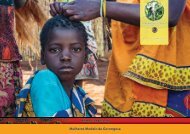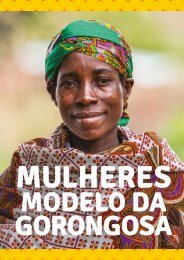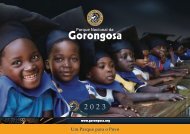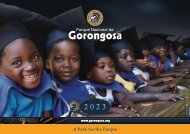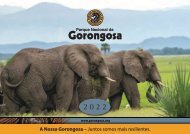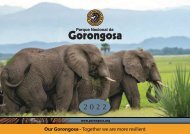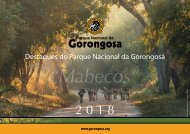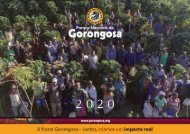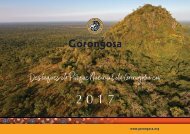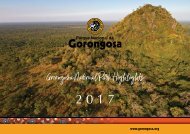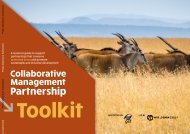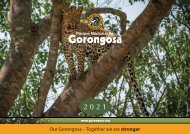2019 Highlights
Create successful ePaper yourself
Turn your PDF publications into a flip-book with our unique Google optimized e-Paper software.
Our Gorongosa – A Park for the People<br />
<strong>2019</strong><br />
© Charlie Hamilton James<br />
www.gorongosa.org
2<br />
Contents<br />
Gorongosa National Park 3<br />
Vision, Mission<br />
In focus 4<br />
Notable events, Conservation and wildlife, Science, Ecotourism, Human development in the Buffer Zone and Integrated agricultural livelihoods<br />
Message from Gorongosa Park Warden 8<br />
Pedro Muagura<br />
Cyclone Idai 10<br />
Gorongosa cares for its neighbours<br />
Gorongosa National Park and Buffer Zone 12<br />
Institutional accomplishments – the Strategic Plan 2020 –2050 and Media Department<br />
The Park 15<br />
Conservation, Science and Ecotourism<br />
Buffer Zone 20<br />
Human development in the Buffer Zone<br />
Profiles 27<br />
Tara Massad, Marcos Chova, Hercilia Benedito Chipanga, Piano Jantar, Dadiva David Salomão and Francisco Santos Samacho<br />
Performance indicators 28<br />
Income from ecotourism in US$, Ecology – comparison of wildlife (herbivore) counts, Number of species documented in Gorongosa National<br />
Park and Number of farmers selling coffee beans<br />
Finances 30<br />
How to engage<br />
The Gorongosa Project Team 33<br />
Gorongosa National Park<br />
Vision:<br />
A thriving, biodiversity-rich, Greater Gorongosa<br />
conservation landscape, which supports Sofala<br />
Province as an engine for resilient and sustainable<br />
development enabling nature experiences and<br />
wellbeing for its people, enriching all of<br />
Mozambique and the world.<br />
Mission:<br />
Advance an integrated multi-partner approach to conservation and to people-centred<br />
development. The Gorongosa Project protects the Park’s biodiversity and ecosystem services<br />
and unlocks its economic potential for the community inhabitants of the Gorongosa Buffer<br />
Zone, Sofala Province, Mozambique and further afield.<br />
We achieve this through:<br />
■■<br />
Protecting our ecosystems and their wildlife through a dedicated, well trained<br />
conservation team equipped with cutting-edge technology<br />
■■<br />
Supporting sound land and water planning, and management, based on world-class<br />
science<br />
■■<br />
Unlocking economic benefits arising from tourism and sustainable natural resource use<br />
that focuses on sustainable forestry and agriculture<br />
■■<br />
Supporting improved human development services in health and education<br />
■■<br />
Developing and communicating a model that can be applied elsewhere for integrated<br />
conservation and human development.<br />
3<br />
© Charlie Hamilton James
In focus<br />
Notable events<br />
Gorongosa – a Park for Peace<br />
On 1 August, <strong>2019</strong> a historic ceremony was held in<br />
Gorongosa to celebrate the Cessation of Hostilities Accord<br />
between the leaders of the Government of Mozambique<br />
and the opposition Renamo Party. The accord established<br />
Gorongosa National Park (GNP) as a ‘Park for Peace’,<br />
delivering human development to the communities that<br />
share the greater landscape.<br />
Cyclone Idai – a challenge met<br />
Cyclone Idai made landfall in Beira on 15 March <strong>2019</strong>.<br />
Every Gorongosa employee became a ‘first responder’,<br />
saving lives and delivering food to stranded families.<br />
Rangers went on foot in the rain to implement these relief<br />
operations. Other team members sourced food and<br />
medicine and packaged the supplies for delivery. We<br />
used helicopters, canoes and vehicles to support the ground<br />
action. In the two months following the landing of Idai, we<br />
delivered 500 tonnes of food to more than 80,000 people,<br />
and provided 2.5 tonnes of maize seeds and 13 tonnes of<br />
sugar bean seeds to replace lost crops.<br />
We also helped to rebuild infrastructure and housing.<br />
The Park’s 400,000 hectares of intact vegetation and<br />
soils absorbed enormous amounts of water, which would<br />
otherwise have made flooding worse in the communities<br />
downstream. Natural areas will play a critical buffering role<br />
in extreme weather events in this coming age of climate<br />
change.<br />
© Jen Guyton<br />
© Brett Kuxhausen / Gorongosa Media<br />
Conservation and wildlife<br />
■■<br />
■■<br />
■■<br />
■■<br />
■■<br />
■■<br />
■■<br />
■■<br />
We reintroduced 14 painted wolves (African wild dogs) in 2018 with great success. Twenty-six pups from three litters<br />
have swelled their numbers to 40. We reintroduced another 15 painted wolves to the Park in October of this year.<br />
The lion population has increased to 146 known individuals, and the elephant population to 800 – and growing.<br />
We now manage the former Hunting Concession Number 12 (C12). We are working with local communities in a<br />
forestry concession to establish a safe wildlife corridor between Gorongosa Park and C12.<br />
During the first half of <strong>2019</strong>, Park rangers rescued 27 trafficked pangolins in Sofala and Manica provinces. Gorongosa<br />
Park wildlife vets cared for them and released them into the wild.<br />
Our rangers seized three leopard skins and 25 elephant tusks outside the Park borders, collaborating with the police to<br />
bring traffickers to justice.<br />
We greatly increased our communications capability with a new Park-wide digital radio system.<br />
We now use the ‘EarthRanger’ domain-awareness system to coordinate and monitor law enforcement operations and<br />
radio-collared wildlife.<br />
Gorongosa Park provided sable, waterbuck, oribi and reedbuck to help rewild Zinave National Park and the Maputo<br />
Special Reserve.<br />
Science<br />
■■<br />
■■<br />
■■<br />
■■<br />
■■<br />
The number of plant and animal species recorded in the Greater Gorongosa landscape (through our scientists’ All Taxa<br />
Biodiversity Inventory) is now more than 6,000.<br />
We inaugurated a new amphitheatre in Chitengo Camp in July with an international Wenner-Gren conference on<br />
primatology. Senior researchers and students from 15 institutions in nine different countries attended the prestigious<br />
event held for the first time in Africa.<br />
The fossil sites east of the Urema River inside the Park (dating to the Late Miocene, 7–10 million years ago), are<br />
yielding a treasure trove of mammal fossils, placing Gorongosa firmly on the global palaeontological map.<br />
We have placed satellite tracking devices on an additional 10 elephants. We now have 26 elephants collared. This<br />
helps us follow the animals and reduce wildlife conflict in the communities that border the Park. We also constructed<br />
‘beehive fences’ along the southern border of Gorongosa. The bees deter the elephants from entering farms.<br />
Gorongosa National Park conducts the only Masters in Conservation Biology in Mozambique and 12 Mozambican<br />
women and men will soon graduate from the two-year program.<br />
‘Landscapes can play a tremendously positive buffering effect –<br />
they generally attenuate the extremes of weather ... water.<br />
And that’s why we need these big landscapes.’<br />
Marc Stalmans – Chief Ecologist of Gorongosa National Park<br />
4<br />
5
Ecotourism<br />
■■<br />
We trained twenty students, who live in communities near the Park, in ecotourism. They passed an accredited<br />
hospitality course in mid-<strong>2019</strong>.<br />
■■<br />
During March to September, 6,432 national and international guests visited Gorongosa Park; 5,402 of them went<br />
on safari drives.<br />
■■<br />
The Park was closed to visitors in April due to Cyclone Idai but we reopened in May <strong>2019</strong>.<br />
■■<br />
Ecotourism revenue totalled US$737,132 through September of this year.<br />
■■<br />
A new luxury tented camp, called ‘Muzimu’, is under construction and will open in mid-2020.<br />
Human development in the Buffer Zone<br />
■■<br />
■■<br />
■■<br />
■■<br />
■■<br />
We now operate after-school Girls’ Clubs and Nature Clubs in 50 primary schools around the Park. Next, we will begin<br />
a program to support local school teachers.<br />
Gorongosa Park is providing bursaries for 37 girls to attend high school.<br />
The Gorongosa Project is negotiating a Memorandum of Understanding with Mozambique’s Ministry of Education to<br />
formalise our work among the schools in the communities around the Park.<br />
We repaired four broken boreholes (water wells) and we maintain another 50 in collaboration with local community<br />
water committees.<br />
Our Park human resources staff conducted planning exercises with 16 traditional leaders in local<br />
communities around Gorongosa to support them in their capacity development plans.<br />
© Brett Kuxhausen / Gorongosa Media<br />
Integrated agricultural<br />
livelihoods<br />
■■<br />
■■<br />
■■<br />
■■<br />
■■<br />
We planted over 300,000 coffee trees in <strong>2019</strong>, a<br />
tenfold increase from previous years, in spite of<br />
damage to the road caused by weather.<br />
Our coffee farmers harvested 6,000 kilograms of green<br />
bean coffee. More than 500 families are now growing<br />
coffee – creating 200 jobs that contribute greatly to the<br />
peace and reconciliation initiative.<br />
The Gorongosa Park Agricultural Livelihood Project is<br />
working to increase its extension services and to<br />
develop anchor markets for cashew nuts and honey<br />
for 3,000 family farmers.<br />
This year our agricultural extension services will reach a<br />
total of 10,000 farmers. Most of these families suffered<br />
in Cyclone Idai.<br />
Four of the Gorongosa National Park graduate students<br />
are researching the nexus of agricultural production,<br />
biodiversity protection, and community upliftment.<br />
‘Environmental protection and economic development are not in conflict.<br />
Environmental protection is not a burden but a source for innovation. It can<br />
increase competition, create jobs, and lifts the economy.’<br />
Chai-Jing, journalist and environmental activist<br />
© Charlie Hamilton James<br />
6<br />
7
Message from Gorongosa Park Warden<br />
Pedro Muagura<br />
<strong>2019</strong> has been a very turbulent year for central Sofala Province, with far-reaching events such as the devastating<br />
Cyclone Idai strike, but on the other hand also the monumental achievement of the peace agreement signed<br />
between the Government of Mozambique and the opposition Renamo Party. By virtue of its location, Gorongosa<br />
National Park has been at the heart of these happenings and has engaged in its all-encompassing conservation<br />
and development mission.<br />
On 15 March, Cyclone Idai made landfall in Beira. Overnight the storm swept across Sofala and<br />
Manica provinces and left more the 600 people dead and affected over 1.3 million. The storm<br />
destroyed hundreds of thousands of homes and thousands of hectares of crops, and ripped off the<br />
roofs of schools and clinics. Trees were uprooted across entire landscapes. But the worst was to<br />
come for those living in areas prone to flooding – many of them in the Buffer Zone of the<br />
Gorongosa National Park. With the Pungue and Urema rivers overflowing, their modest homes<br />
were flooded, fields and harvests destroyed and families cut off from any land access and help for<br />
weeks. I am immensely proud to say that the Gorongosa team stepped in wholeheartedly and<br />
immediately – before the international response could even get into motion – and started a decisive<br />
emergency relief effort. For months we not only rehabilitated the Park itself – fixed roads, bridges,<br />
cleaned up fallen trees and set up our projects anew, but more importantly, we transformed into a<br />
food distribution and medical support team that assisted our Park neighbours in this time of need.<br />
Overall, we delivered 500 tonnes of food to more than 80,000 people in some of the worst<br />
affected areas, mostly south of the Park. We hired two helicopters and were able to reach those<br />
no one else was able to reach. We set up an emergency response unit and orchestrated a wellcoordinated<br />
relief effort.<br />
Thankfully, we received support from many concerned individuals, businesses and organisations and<br />
raised an astonishing US$400,000 from our web-based fundraising effort alone. The team of African<br />
Parks also provided much welcome relief to our Buffer Zone with their helicopter and technical team.<br />
I am amazed at how much we could all achieve together during this trying time. Thank you all for your<br />
hard work and your support!<br />
‘Having the signing of the cessation of hostilities accord in<br />
Gorongosa is an opportunity to show the world the intrinsic<br />
bond that exists between conservation,<br />
peace and development.’<br />
Pedro Muagura, Park Warden, Gorongosa National Park<br />
© Charlie Hamilton James<br />
The post-cyclone rehabilitation is an ongoing responsibility,<br />
and Idai’s aftermath will be felt for years to come. Some<br />
of our Buffer Zone development programs have suffered<br />
significant setbacks and we are now focusing on helping the<br />
local farmers to access seeds for the new growing season,<br />
while other programs are only slowly picking up impetus<br />
after the catastrophe.<br />
We gained fresh momentum and hope however, by the<br />
signing of the epic Peace Accord between the Government<br />
of Mozambique and the opposition Renamo Party. While<br />
they had already agreed to a ceasefire in December 2016,<br />
it took almost three years before the peace deal was<br />
accomplished. Gorongosa National Park had been central<br />
in the negotiation process throughout, and this historical<br />
moment remains closely connected to the Park.<br />
All these natural and political circumstances have had a<br />
strong bearing on our conservation mandate and on the<br />
Buffer Zone communities we work with so closely. I do not<br />
know of any other park in the world that would have been<br />
as strongly affected and linked to the destiny of the people<br />
living around it as we were in <strong>2019</strong>. More than ever we<br />
deserve to call it ‘Our Gorongosa – A Park for the People’.<br />
Join me by reading our <strong>Highlights</strong> <strong>2019</strong> report, which gives<br />
you a glimpse of each of our programs during this past year.<br />
We are immensely grateful to all our supporters, our donors<br />
and our friends who continue to help us deliver our work.<br />
Your motivation and reinforcement are what keep us going!<br />
Pedro Muagura<br />
8 9
Caia<br />
© MODIS image captured by NASA’s Aqua satellite - EOSDIS Worldview<br />
MOZAMBIQUE<br />
Beira<br />
Indian Ocean<br />
EN1<br />
Vila Gorongosa<br />
Nhamatanda<br />
Cyclone Idai<br />
Gorongosa cares for its neighbours<br />
EN6<br />
EN1<br />
EN6<br />
EN1<br />
Caia<br />
Legend<br />
Community conservancies (conceptual)<br />
Sustainable forestry Inhaminga concessions<br />
Coutada (hunting area)<br />
Special reserve<br />
Lake Urema<br />
Muanza<br />
Gorongosa National Park<br />
Buffer Zone<br />
Most affected communities<br />
Normal water levels<br />
Flooded 20 March <strong>2019</strong><br />
Major food drops<br />
All our Park departments were on high alert when Cyclone Idai made landfall on 15 March <strong>2019</strong>. Our Park<br />
rangers immediately walked through heavy rain and flooded land to reach those trapped on termite mounds<br />
or in trees. They brought emergency rations and assistance sufficient for a few days until we could mobilise<br />
helicopters, canoes and vehicles. During the first month, GNP staff, with help from African Parks and others,<br />
delivered 140 tonnes of food and water to over 30,000 people. By May, this had risen to 220 tonnes to over<br />
40,000 affected community members. We were also directly involved in planning and coordination with<br />
national and international authorities in the flood assistance program, which included emergency rehabilitation<br />
of infrastructure, communications and transportation. Our distribution of start-up packs of seeds and other<br />
agricultural essentials has allowed communities to replant for future food stability.<br />
It was very clear that the Park itself played an essential part in mitigating damage caused by the cyclone. Its<br />
vast vegetated area and network of streams and rivers acted like a sponge, absorbing huge quantities of water,<br />
which was still being gradually released five months after the actual event. It was practical proof that intact<br />
landscapes have a buffering effect on extremes of weather – especially wind and water, as well as serving as<br />
reservoirs for effective and functioning biodiversity systems.<br />
The positive reaction to our appeals on social media raised essential funds for our work after Cyclone<br />
Idai – and helped save many of our neighbours from total destitution.<br />
Marromeu<br />
EN1<br />
Vila Gorongosa<br />
10 11<br />
EN6<br />
EN1<br />
Nhamatanda<br />
Bebedo<br />
EN6<br />
Chitengo<br />
Nhapoca<br />
Djuchendje<br />
Catemo<br />
Muanadimae<br />
Lake Urema<br />
Nhamacunguere<br />
EN1<br />
Muanza<br />
SCALE<br />
Inhaminga<br />
0 5 10 20 30 40 50 kilometres<br />
Marromeu
The Strategic Plan Result Outcomes<br />
Improved capacity of GNP to preserve, protect and<br />
manage the diverse ecosystems within the Park<br />
as one of the last wild places in Africa.<br />
Increased ability to better<br />
scientifically understand GNP<br />
diverse ecosystems and the<br />
interaction with Buffer<br />
Zone communities.<br />
Improved community<br />
capacity and civic<br />
participation in local<br />
development processes<br />
including planning,<br />
decision-making and<br />
oversight.<br />
Improved sustainable economic<br />
opportunities for men and<br />
women living in the GNP’s Buffer<br />
Zone through rural productive value<br />
chain development, including addressing<br />
barriers for women to benefit from these<br />
opportunities.<br />
Gorongosa National Park and Buffer Zone<br />
Institutional accomplishments – the Strategic Plan 2020 –2050<br />
For the past 18 months, the Park staff has engaged in a participatory planning effort, which culminated in the<br />
drafting of GNP’s 30-year strategy. Pursuing its dual conservation and Buffer Zone development vision, the<br />
strategy lays the foundation for three decades of investments up to 2050. The 30-year strategy will be<br />
underpinned by a five-year business plan and shorter-cycle operational plans.<br />
Over the past year, numerous consultations have taken place, not only within the Park, but also with key<br />
stakeholders — local Buffer Zone communities, district government and partner organizations, and various<br />
donors supporting or hoping to support the Park in its ambitious conservation and development work.<br />
The existing Gorongosa Biofund self-financing initiative will continue to operate in conjunction with the<br />
Park-owned for-profit entities, Produtos Naturais and Turismo de Gorongosa This will augment donor funding<br />
for focused human development in the Buffer Zone.<br />
Based on GNP’s 15 years of learning and extensive consultations with primary and secondary stakeholders over<br />
the course of this two-year strategic planning process, the Result Outcomes need to contribute to and fulfill the<br />
Ultimate Outcome of the Strategic Plan.<br />
‘I’m very conscious of the fact that you can’t do it alone. It’s teamwork.<br />
When you do it alone you run the risk that when you are<br />
no longer there nobody else will do it.’<br />
Wangari Maathai, founder of the Green Belt Movement<br />
and 2004 Nobel Peace Prize Laureate<br />
12<br />
© Jen Guyton<br />
Increased access to, and performance of, education and health services in<br />
the GNP and Buffer Zone, with particular emphasis on girls and women.<br />
13
Media Department<br />
GNP was at the forefront of much press attention this year,<br />
with prominent coverage in National Geographic Magazine,<br />
the New York Times, The Guardian, Associated Press and<br />
a number of other top international and national media<br />
outlets. Our media and communications team also<br />
provided constant news updates via social media, press<br />
releases, newsletters and the Park’s website. The creation<br />
of films and short videos by Gorongosa Media further<br />
communicates the Gorongosa story to millions of people<br />
via television and online platforms. Gorongosa Media’s<br />
award-winning feature documentary film about<br />
Gorongosa’s rangers, ‘On the Front Line’ screened at the<br />
prestigious DC Environmental Film Festival in March. PBS<br />
International acquired the film for global television<br />
distribution, allowing audiences around the world the<br />
opportunity to view it.<br />
A highlight of the year was the premier of Gorongosa Media<br />
and HHMI Tangled Bank Studios’ newest film, ‘Our<br />
Gorongosa – A Park for the People’ to a full house at the<br />
Oprah Winfrey Theatre in the Smithsonian National<br />
Museum of African American History and Culture in<br />
Washington. The event, on 15 May, not only highlighted<br />
the Park’s development and conservation work with the<br />
communities in and around Gorongosa National Park, but<br />
also the integral role the Park played in recovery efforts<br />
following Cyclone Idai. A significant number of luminaries<br />
of the conservation and development sectors attended the<br />
event. PBS International also acquired ‘Our Gorongosa’ for<br />
global distribution.<br />
© Brett Kuxhausen / Gorongosa Media<br />
© Brett Kuxhausen / Gorongosa Media<br />
The Park<br />
Conservation<br />
Painted Wolves<br />
The original pack of 14 painted wolves has grown beyond expectation and there are now around 40 ‘mabecos’ in the Park.<br />
The alpha female ‘Beira’ produced a litter of 11 pups in April – after losing her first litter to an African python last year<br />
shortly after their reintroduction. Surprisingly, the beta female, ‘Nhamagaia’, also produced a litter of eight, which the pack<br />
uncharacteristically accepted without any problems. Four of the original group split off from the main pack earlier this year<br />
and the lone female subsequently produced a litter of eight. The Park introduced an additional pack of 15 painted wolves<br />
in October to swell the numbers of this apex predator.<br />
Coutada 12<br />
The incorporation into the Gorongosa Project of the 2,800km 2 Coutada 12 , with its increased protection, has almost<br />
doubled the size of the Park. We now also manage a forestry concession of 28,560 ha, which has provided a critical linkage<br />
and corridor between the two conservation areas. We have developed an initial management plan for the new area and<br />
are investigating additional resources for its implementation. We continue to invest in our work with local communities to<br />
establish sustainable forestry-based community conservancies and community guard systems throughout the Buffer Zone.<br />
Pangolin rescue<br />
African pangolins are included in the Convention on International Trade in Endangered Species (CITES) Appendix 1<br />
(endangered) mammals list. The biggest threats facing these animals are live trafficking and poaching. During the first half of<br />
<strong>2019</strong>, Gorongosa rangers rescued 27 trafficked pangolins in Sofala and Manica provinces. We released them after<br />
dedicated care from our resident wildlife vets. This year rangers also seized three leopard skins and 25 elephant tusks<br />
outside the Park, collaborating with the police to bring the traffickers to justice.<br />
Beehive fences<br />
Farming communities in the Buffer Zone experience seasonal damage from crop-raiding elephants. We introduced beehive<br />
fences, a concept developed in Tanzania and used with success in other African countries to keep elephants away from<br />
croplands, and constructed 30 community silos to safely store harvests.<br />
‘The Wilderness holds answers to more questions than we<br />
have yet learned to ask.’<br />
Nancy Newhall, photography critic and conservationist<br />
14<br />
15
Science<br />
Elephant ecology<br />
A PhD study is specifically addressing issues related to the spatio-temporal dynamics in landscape occupancy by different<br />
family units of elephants, their seasonal and spatial movements in relation to human presence and how these movements<br />
correlate with human-wildlife conflict and the perceptions of the communities. We fitted a further 10 elephants with<br />
satellite collars, bringing the total number of collared elephants to 26. The human-wildlife coexistence team is using the<br />
data from the collars to identify incursions and to direct resources to counter them.<br />
Biodiversity assessments<br />
The number of plant and animal species recorded in the Greater Gorongosa landscape (through our scientists’ All Taxa<br />
Biodiversity Inventory) is now more than 6,000. During May, a short expedition documented the biodiversity of the Dingue<br />
Dingue wetland south of the Urema-Pungue confluence, focusing on bird diversity. We conducted two counts of the large<br />
water bird colony on Lake Urema, recording a total of 3,791 nests of seven different species.<br />
In conjunction with our research partners, we published a total of 11 peer-reviewed articles and additional publications in<br />
the international scientific literature that deepened insights into the dynamics and biodiversity of the Park. We consolidated<br />
the results of 50 years of aerial wildlife counts of Gorongosa National Park, translated them to a common denominator and<br />
analysed them for trends. Plos One Journal published the results. This represents the first objective integrated source of data<br />
on the ebb and flow of the large wildlife of the Park over a period of half a century.<br />
In November/December 2018, we presented the completed report from the Teaching Biodiversity Survey at Chimanimani<br />
National Reserve to ANAC. Overall, the survey confirmed the presence of 42 species of mammals, 231 species of birds,<br />
45 species of reptiles, 22 species of amphibians, 454 species of insects and other arthropods, and 176 species of vascular<br />
plants. We observed a number of species never before recorded from Mozambique, such as the bat Pipistrellus rusticus,<br />
hawkmoth Pseudoclanis postica, and katydid Ovonotus incisus. We could also tentatively identify several species as new to<br />
science, including a leaf katydid Gonatoxia sp. n. and butterfly Gonophodes sp. n.<br />
© Piotr Naskrecki<br />
Science Education<br />
Twelve Mozambican students are in the final year of their<br />
Masters in Conservation Biology in the Park. The<br />
consortium hosting the degree includes the Park, the<br />
Universidade Zambeze, Universidade Lúrio, and Instituto<br />
Superior Politécnico de Manica, with assistance from the<br />
University of Lisbon in Portugal. The students are presently<br />
concentrating on data collection, analysis and write-up for<br />
their theses.<br />
From 28 July to 16 August <strong>2019</strong>, we hosted the second<br />
Oxford-Gorongosa Paleo-Primate Field School. An<br />
international team of scientists guided eight students<br />
from Oxford University and five students from University<br />
Eduardo Mondlane in theoretical and practical aspects of<br />
palaeontology, archaeology, speleology and primatology.<br />
Data integration – the Larger Gorongosa Landscape<br />
A concerted effort during this year consolidated data on<br />
the larger Gorongosa Landscape to make them more<br />
accessible to staff and external researchers. Several new<br />
data sets included a comprehensive assessment of the<br />
number of households and extent of cultivation, through<br />
the analysis of satellite imagery across an area of more than<br />
1,800,000 ha. This culminated in the compilation of an<br />
‘Environmental Atlas’ that contains some 60 maps.<br />
Palaeontology and primatology<br />
Senior researchers and student scientists from 15 institutions in nine different countries came together in the Park during<br />
July for an international Wenner-Gren conference. The central theme of the conference was about primates such as<br />
baboons and savanna monkeys adapting to complex and ever-changing environments. This is the first time that the<br />
conference has taken place in Africa.<br />
The Paleo-Primate Project of Gorongosa completed its fourth field season this year. Excavations of the site, discovered in<br />
2018, continue and we are uncovering a large number of mammal fossils representing a diversity of species. Preliminary<br />
analysis indicates that this site is poised to fill in some major gaps in the Miocene fossil mammal record in Africa. This places<br />
Gorongosa firmly on the palaeontological map.<br />
© Charlie Hamilton James<br />
16<br />
17
Ecotourism<br />
Turismo de Gorongosa<br />
Ecotourism is a natural offshoot of any national park and<br />
thus needs to be grown and developed as a successful<br />
component of a park. Turismo de Gorongosa is a<br />
multi-faceted, for-profit company that is the driving force<br />
behind various tourism initiatives, from guided tours, the<br />
curio shops, staff training and, most importantly, the current<br />
development of Muzimu Tented Camp.<br />
Turismo de Gorongosa is a dynamic company that serves<br />
the people within the Buffer Zone. It aims to facilitate the<br />
integration of all people in Park activities, regardless of<br />
gender, political convictions and skills levels. It is there to<br />
supplement livelihoods through skills development, thus<br />
creating increased self-worth and personal growth.<br />
Hospitality training<br />
Turismo de Gorongosa initiated a three-week intensive<br />
hospitality training program with local communities to offer<br />
training in hospitality services and management. Course<br />
organizers selected twenty young men and women from<br />
various communities in the Buffer Zone and Sofala Province<br />
to participate in the program. A hospitality training<br />
institute based in Maputo conducted the course, which<br />
carries accredited certification. All the students passed the<br />
final evaluations and theory examinations.<br />
Continued focus on training and skills development is<br />
essential in all realms of hospitality and additional<br />
training programs are scheduled for the rest of this year and<br />
2020. Turismo de Gorongosa plans to develop a hospitality<br />
training academy to accommodate students attending these<br />
programs.<br />
© Brett Kuxhausen / Gorongosa Media<br />
© Brett Kuxhausen / Gorongosa Media<br />
Muzimu Tented Camp<br />
Muzimu Tented Camp is a small intimate camp that is designed to merge into its surrounding natural environment. It<br />
broadens the current tourism offering found in Chitengo. Its proximity to the core area of the Park and Lake Urema ensures<br />
excellent viewing and wildlife encounters.<br />
In keeping with sound ecological practices to minimize impact on the environment and to ensure the safety of patrons, the<br />
camp is being constructed on elevated walkways connecting the facilities and tented accommodation. The raised elevation<br />
provides a precaution against rising water levels during heavy rainfall, while allowing the free movement of wildlife around<br />
the camp. Muzimu is in the first stage of construction and we anticipate that it will be ready for operation in mid-2020.<br />
Safari Activity Center<br />
By the end of September this year, 6,432 guests visited the Park and participated in activities at the Safari Activity Centre.<br />
Despite Cyclone Idai’s disruption of the safari season, the number of tourists has shown a remarkable upsurge. Visitors have<br />
hailed predominantly from Mozambique and Portugal, followed by the USA, Brazil, South Africa and France. Turismo de<br />
Gorongosa has added three new safari vehicles to the fleet to accommodate this growth.<br />
Cycle tours through the local communities proved very popular, as did the boating experiences on Lake Urema, which<br />
were possible shortly after the Park was re-opened in May. More than 5,400 visitors participated in vehicle safaris during<br />
this period. The safari department generated a total revenue of US$737,142 by the end of September <strong>2019</strong>.<br />
‘Keep close to Nature’s heart... and break clear away, once<br />
in a while, and climb a mountain or spend a week in the<br />
woods. Wash your spirit clean.’<br />
John Muir, naturalist, author and conservationist<br />
18<br />
19
Buffer Zone<br />
Human development in the Buffer Zone<br />
The Gorongosa National Park is unique in its mission not only to deliver world class conservation, but at the same time<br />
invest in the human development of 200,000 people living in the officially designated Park Buffer Zone. This mission gains<br />
even more specific importance in the context of the Cessation of Hostilities Accord signed on 1 August <strong>2019</strong>. The Park is<br />
taking on an important post-conflict stabilisation role with its support of social services such as improved education and<br />
health, as well as in employment creation, livelihood support and community-based natural resource governance. Gender<br />
and social inclusion, empowering women and girls, and ensuring that all segments of society are included and reached in<br />
the Park-led programs are important elements of the Park’s human development work.<br />
Education<br />
This year we have made a dedicated effort to broaden the education strategy of the Park to have a better reach and impact<br />
on the younger generation. Cyclone Idai slowed our plans somewhat, as a number of schools in the south were damaged<br />
and needed urgent rehabilitation.<br />
The Girls’ Clubs initiative continues to be one of Gorongosa Project’s main human development initiatives in the Buffer<br />
Zone, offering support to girls to stay at school and learn important life skills. The 50 existing Girls’ Clubs and Nature Clubs<br />
(involving over 2,000 girls) cover more than 50 per cent of the primary schools We hope to double this number during the<br />
new school year, which starts in January 2020. Several members of the clubs who have successfully completed primary<br />
school have received bursaries to attend secondary school. At present, 37 girls are completing their studies with these<br />
bursaries – a major increase in girls from the Buffer Zone attending high school. There are now Youth Clubs at two of the<br />
four high schools in or near the Buffer Zone (Vila de Gorongosa and Vila de Inhaminga). The clubs provide study support<br />
and a dedicated science program for deserving children, girls and boys, preparing the students for enhanced careers –<br />
including those associated with the Park. The program aims to create human capital with the right skills-set and personal<br />
engagement to become part of our conservation and development vision. We are formalising other educational<br />
opportunities through professional training in the tourism sector and expanding the Park’s internal apprenticeship and<br />
internship program, providing on-the-job learning opportunities for young professionals from the Buffer Zone.<br />
Our new focus on investing in teacher education, in conjunction with District Education Departments and the national<br />
Ministry of Education aims to support the formal education system. We are negotiating a Memorandum of Understanding<br />
with the Ministry of Education, in this regard. Our objective is to build a community of practice, creating associations with<br />
conservation, peace building and community development. We hope that by establishing pilot Teachers’ Clubs in 2020 we<br />
can enhance these qualities.<br />
We have been able to raise funds to repair the damage caused by Cyclone Idai to some of our partner schools. Plans<br />
are also underway to rehabilitate educational structures in the Mount Gorongosa area, where prior to the Peace Accord,<br />
schools remained closed for several years.<br />
© Jen Guyton<br />
© Jen Guyton<br />
Health<br />
Human resources input maintains the provision of health<br />
services in the Buffer Zone. To date, there are 88<br />
community health workers, 129 traditional birth attendants.<br />
and 159 model moms active in four districts (Gorongosa,<br />
Nhamatanda, Muanza and Cheringoma).<br />
Model moms support young mothers with information on<br />
caring for their new babies properly, especially in hygiene<br />
and nutrition. Traditional birth attendants continue to<br />
receive training and provide education and support to<br />
pregnant women throughout their pregnancy and delivery,<br />
until their babies turn one year old. Community health<br />
workers are local Buffer Zone inhabitants and are part<br />
of the national health care system. They provide primary<br />
medical assistance and educate local communities on basic<br />
health issues.<br />
By the end of July, 79 mobile health brigades consisting of<br />
public health technicians were functional in the districts of<br />
Gorongosa, Nhamatanda, Dondo, Muanza and Cheringoma.<br />
After Cyclone Idai this year, the mobile brigades, with<br />
assistance from Portuguese physicians, provided support<br />
and cholera vaccinations to communities in Nhamatanda<br />
and Gorongosa.<br />
On the sanitation front, our WASH team was closely<br />
involved in the post-cyclone recovery efforts, especially in<br />
the south of the Park where a number of facilities were<br />
destroyed. We started rehabilitating boreholes in August.<br />
We have also trained three new water and sanitation<br />
committees in the Gorongosa district and hired a WASH<br />
technician for Cheringoma district. The community has<br />
contributed just over US$1000 to buy parts for broken<br />
boreholes when necessary. Since the beginning of the<br />
program in 2016, we have developed and maintained a<br />
constant number of 50 functioning boreholes, which are<br />
managed by relevant community borehole committees.<br />
20<br />
21
CBNRM, conservancies, governance<br />
Community-based natural resources management (CBNRM)<br />
and the establishment of formal community conservation<br />
areas, so-called conservancies, are centrally positioned in<br />
the new 30-year strategy for Gorongosa National Park and<br />
its Buffer Zone. Through a formal collaboration with the<br />
Namibian Association of CBNRM Service Organisations<br />
(Nacso), our team has further developed the Park’s<br />
approach to community-led conservation, and we are<br />
actively pursuing investment in these long-term partnerships<br />
to strengthen local-level self-governance of communities.<br />
In <strong>2019</strong>, we focused on establishing community<br />
conservation along the eastern Park boundary,<br />
strengthening the corridor to Coutada 12. In this area,<br />
forestry resources are of particular importance. We are<br />
working with the only sustainable-forestry-certified<br />
commercial concession in Mozambique, Levas Flor, to help<br />
the natural resource management committees establish and<br />
manage sustainable forestry undertakings – providing<br />
meaningful and long-term income to local communities.<br />
The signing of the Peace Accord, as well as the introduction<br />
of a new decentralisation framework, has led to a special<br />
interest in furthering local-level community-led governance.<br />
The Park’s experience in natural resource-related<br />
governance with local communities has led to a significant<br />
involvement in local-level initiatives and thus created a<br />
strong governance linkage. The 30-year strategic plan will<br />
elevate these efforts in the future.<br />
In the past years, it has been challenging to effectively<br />
engage local communities in responsible and sustainable<br />
management of natural resources. However, as the benefits<br />
from tourism, sustained resources and employment creation<br />
in responsible agriculture, and reforestation initiatives<br />
have become clear, there are more visible incentives for a<br />
pro-conservation approach.<br />
© Gorongosa Media<br />
RIGHT:<br />
Mozambique President Filipe Jacinto Nyusi, left,<br />
and Renamo leader Ossufo Momade signing a cessation<br />
of hostilities accord at Gorongosa National<br />
Park, Thursday, 1 August, <strong>2019</strong>.<br />
© Gorongosa Media<br />
Cyclone Idai demonstrated how important it is to manage natural resources well, and that land-use planning is vital. Settling<br />
in flood areas may be good for agriculture, but will be dangerous if flooding becomes more common. Our participatory<br />
approaches to working with communities and district government is aimed at improved planning to develop sound land-use<br />
strategies, including setting aside vulnerable areas for conservation.<br />
In 2018/19 we undertook community visioning processes with natural resource management committees in 16 local<br />
communities in the Buffer Zone and started the same process at the village level. These discussions allowed the<br />
communities to reflect on their behaviour and attitudes; how they relate to their future, and what the community can do<br />
to ensure a desirable future. We also involved community rangers and activators in the process to guide discussions about<br />
conservation education, and enforce local and state regulations on natural resources access, control and use.<br />
Agricultural Livelihoods Program: farming for biodiversity with inclusivity<br />
The Gorongosa Project’s Agricultural Livelihood Program has two core values: inclusive value chains and farming for<br />
biodiversity. Inclusivity, in practice, centers around working with women for business and employment creation,<br />
empowerment, gender training and solutions, financial inclusion, and access. It also encompasses capturing traditional<br />
knowledge through free and informed consent, intergenerational learning, and preservation and use of indigenous<br />
knowledge. The project is community driven and coordinates its efforts through working closely with community leaders<br />
and organizations in natural resources management, education and health. Biodiversity is conserved by key principles of<br />
land management, agroforestry, and promoting ambassador species that are symbolic for issues or ecosystems to build<br />
awareness and behavior change.<br />
As a result, the project has proved resilient against the periodic onset of regional instability and extreme climatic events,<br />
including the recent devastation by Cyclone Idai, which severely affected infrastructure. Gorongosa Coffee also offers small<br />
producers the option for expansion over time, focusing on developing emerging farmers through an array of agroforestry<br />
alternatives such as honey production, inter-row cropping options and seasonal employment. This critical flexibility has<br />
provided the impetus for communities to adopt conservation principles and take ownership of the project.<br />
‘Gorongosa ... is no longer a centre of violence between brothers and against<br />
the flora and fauna that exists here.’<br />
Filipe Jacinto Nyusi, President of the Republic of Mozambique<br />
22 23
Opportunities for peace and reconciliation in coffee<br />
Following the Peace Accord, and growing interest from community members on Mount Gorongosa, the program established<br />
100 hectares of coffee plantation for smallholder coffee farmers. By the end of August <strong>2019</strong>, over 500 emerging<br />
farmers on Mount Gorongosa (100 of whom are women) were growing coffee trees. Over 70 farmers brought in a crop<br />
(compared to 20 last year) and pay-outs ranged between US$80 to $130 per farmer. This is a major achievement, complementing<br />
local annual cash income from agricultural produce by 100 per cent. Additionally, some payments have reached<br />
remote<br />
communities who retreated into the forests and the Park during the civil unrest; this is the first important step to creating<br />
post-conflict opportunities. The project established basic financial literacy training and is working with the community to<br />
create savings programs aligned with their values and the conservation needs of the rainforest.<br />
The coffee value chain represents an unprecedented opportunity for the people of the mountain as an alternative to<br />
political strife and conflict. Beyond the community development and conservation benefits, coffee production represents an<br />
important arm of the Gorongosa Project’s target of sustainable financing. Developing these high-value products will help to<br />
fund the Park’s very important work for the next 25 years. This year also represents a milestone, as Gorongosa Coffee is the<br />
first ever coffee exported from Mozambique; placing the country as the first new single-origin coffee-producing country in<br />
over five years.<br />
Next year we will plant an additional 100 hectares of coffee as part of a ten-year roll out program. We are sourcing different<br />
varieties from Brazil to test the local conditions on Mount Gorongosa, and provide farmers with access to the best genetic<br />
seed stock in the world.<br />
‘When we plant trees, we plant the seeds<br />
of peace and seeds of hope.’<br />
Wangari Maathai, founder of the Green Belt Movement and 2004 Nobel Peace Prize Laureate<br />
© XXX<br />
© Charlie Hamilton James<br />
© Brett Kuxhausen / Gorongosa Media<br />
Creating sustainable anchor markets –<br />
cashew, honey and much more<br />
The Agricultural Livelihoods Program is championing the<br />
development of ‘anchor markets’ for cashew nuts and<br />
honey as part of an integrated approach in the Gorongosa<br />
National Park’s Buffer Zone. Not only does the program<br />
provide extension services to smallholder farm families, but<br />
it operates in close collaboration with Produtos Naturais<br />
da Gorongosa, the for-profit arm of the project, capturing<br />
value-adding opportunities and bringing profits back to the<br />
stakeholders in the Buffer Zone. The development of these<br />
anchor markets includes key investments into infrastructure<br />
for agri-processing, aggregation, access to improved seed<br />
varieties and training methods.<br />
The project works with over 3,000 registered farmers in<br />
the Buffer Zone, some already growing cashew trees, while<br />
others are involved with producing honey, horticulture<br />
production or ground nuts with the support of the<br />
Gorongosa Project. This year extension services will reach<br />
a total of 10,000 farmers to expand the program’s impact<br />
and support families that were severely impacted by the<br />
cyclone.<br />
Extension officers working with cashew farmers have also<br />
established a lead farmer approach (20 lead farmers),<br />
providing approximately 200 existing cashew farmers with<br />
new seedlings. The program has built four cashew nurseries<br />
(one in each district of the Buffer Zone) to better serve local<br />
communities with quality cashew seedlings. These nursery<br />
sites also double as integrated working farms, model<br />
horticulture nurseries and training sites for smallholder<br />
farmers. In the future, they will become part of a service to<br />
help aggregate production to improve prices.<br />
The project is developing a medium-scale cashew processing<br />
plant in Vila Gorongosa as an agricultural processing hub,<br />
with improved processing facilities for honey. The<br />
distribution of an additional 400 beehives in the Buffer<br />
Zone will help to justify capitalization, and piloting a new,<br />
higher yielding hive for promising producers will mean that<br />
yields in 2020 will be greater than ever.<br />
24<br />
25
Profiles<br />
Tara Massad<br />
Marcos Chova<br />
Hercilia Benedito Chipanga<br />
Piano Jantar<br />
Dadiva David Salomão<br />
Francisco Santos Samacho<br />
Director of the Master’s Program in Conservation Biology<br />
Hello! My name is Tara Massad, and I’m lucky enough to have<br />
joined the Gorongosa team for the second time in 2018. I first<br />
came to Mozambique as a Peace Corps volunteer, where I<br />
taught high school biology before returning to the U.S. to<br />
complete my PhD in tropical chemical ecology.<br />
In 2013, I read an article about the Gorongosa Restoration<br />
Project, and was inspired to inquire if they might need an<br />
ecologist to help with their efforts. Serendipitously, they were<br />
looking for someone to organize the new E.O. Wilson<br />
Biodiversity Lab, and I spent an exciting year as the lab’s<br />
research manager. I then moved back to the U.S. to teach, but<br />
I quickly understood I wanted to serve populations with greater<br />
needs and to spend more time in the field. I found my way back<br />
to Gorongosa to help run the innovative Master’s in<br />
Conservation Biology Program. I love working with the students,<br />
and I am very grateful to be able to dedicate my energies to the<br />
impactful education and research programs in GNP.<br />
Lead supervisor in the Agricultural Livelihoods Program<br />
I am the lead supervisor for the honey and reforestation sector<br />
of the Agricultural Livelihoods Program. I have been with the<br />
Park for over 10 years and have a passion for forests. I have<br />
worked on the mountain to help re-establish forests along the<br />
river margins and am very involved in the human-animal<br />
coexistence project, which has successfully installed over 40<br />
beehive fences that have proved effective at keeping elephants<br />
out of the community.<br />
Most recently, I was requested to remove several beehives from<br />
the local school, Missao Cristo Rei de Gorongosa. The school<br />
responded with a gracious thank you note.<br />
Community relations manager<br />
I was born and grew up in Xai-Xai, Gaza Province. I have a<br />
degree in forestry engineering, which taught me to be<br />
passionate about community-based natural resources<br />
management, where communities contribute to conservation<br />
but also benefit from conservation. Since qualifying, I have<br />
worked extensively with communities in CBNRM. I am now<br />
the community relations manager in the GNP. This is all about<br />
creating capacity at the community level to lead natural<br />
resources management and also to promote governance<br />
approaches.<br />
I am very grateful to be part of the dynamic and diverse team<br />
of GNP, and I believe that the future of the Park depends on<br />
the communities understanding the importance of establishing<br />
firm relations with the Park. I am happy to be one of the team<br />
to work with communities on behaviour changing strategy that<br />
will promote knowledge of the value of conservation and the<br />
benefits that it can generate. I appreciate using a development<br />
approach to achieving conservation goals.<br />
Ecosystem integrity program officer<br />
I have worked in the Gorongosa Park for 11 years and my main<br />
role is to collaborate with communities in the Buffer Zone as a<br />
negotiator and conservationist. Through dialogue and conflict<br />
resolution, I have persuaded many families living in the Park to<br />
re-settle voluntarily in the Buffer Zone, where they have access<br />
to clean water, education services and agricultural development<br />
programs.<br />
At present I lead an inter-departmental program focused on<br />
fostering human-wildlife co-existence along the Pungue River.<br />
My team and I construct community silos and help implement<br />
a beehive elephant fence to prevent elephant raids on food<br />
stocks.<br />
I was also on the frontlines during the early days post-Cyclone<br />
Idai, during which we provided emergency assistance to the<br />
Park’s neighboring communities devastated by the storm.<br />
Tourism guide<br />
Hello! I am Dadiva David Salomão, 18 years old and from the<br />
Nhamatanda district of Sofala province. Although I don’t have<br />
much formal training, I have participated in several educational<br />
programs ranging from HIV/AIDS education and gender<br />
facilitation, the mathematics Olympiad in the district phase and<br />
a literacy program to teach the elderly to read and write.<br />
While in Grade 11, I had the privilege of participating in a youth<br />
seminar on conservation biology promoted by the scientific<br />
department of Gorongosa National Park. In 2018, I took part in<br />
a program ‘The girl in school’, and with all that I learned, I<br />
designed my own projects related to sexual harassment in<br />
schools, drug abuse and other topics.<br />
In March this year, as I couldn’t afford to attend university, I<br />
joined Turismo da Gorongosa and am enrolled in the tourist<br />
guide course. I want to become a safari guide and work in the<br />
Park to share what I have learned. I am working very hard to<br />
improve my English and the knowledge I need to be a top<br />
guide.<br />
Nhambita natural resources management committee<br />
I am President of the Natural Resources Management<br />
Committee (NRMC) of Nhambita community and live near the<br />
main entrance of Chitengo. My mission is to lead the process<br />
of management, conservation and protection of the natural<br />
resources in my community around the Park, with the focus on<br />
community members’ mobilization against poaching,<br />
uncontrolled fires, illegal logging, and land management among<br />
others. I am part of the horticulture group, with technical<br />
assistance from Gorongosa National Park community relations<br />
and agriculture sectors, where I integrate conservation<br />
agricultural practices and environmental management.<br />
Every year, my community receives 20 per cent of the Park<br />
revenues from tourism activities as recognition of its contribution<br />
to the conservation objectives of the Park and as custodians of<br />
its natural resources. I facilitate the community planning process,<br />
which is very important for the sustainable development of the<br />
community. I am passionate about my work on sustainable<br />
development and encourage young people (men and women)<br />
to be part of the committee and other social groups in the<br />
community.<br />
26<br />
27
Performance indicators<br />
1. Income from ecotourism in US$ 2. Ecology – comparison of wildlife (herbivore) counts 3. Number of species documented in Gorongosa National Park 4. Number of farmers selling coffee beans<br />
<strong>2019</strong> – 737,132<br />
2018 – 654,000<br />
2017 – 282,840<br />
2018 – 96,633<br />
2016 – 77,902<br />
2014 – 70,837<br />
<strong>2019</strong> – 6,284<br />
2018 – 5,775<br />
2017 – 5,001<br />
<strong>2019</strong> – 70<br />
2018 – 20<br />
28 29<br />
© Brett Kuxhausen / Gorongosa Media
Finances<br />
Income and Expenditure<br />
<strong>2019</strong> Revenue US $<br />
10%<br />
5% 2%<br />
<strong>2019</strong> Expenses US $<br />
7%<br />
7%<br />
Co-sponsor<br />
specific activities<br />
Join a circle of<br />
annual givers e.g.<br />
become a Business Club<br />
member<br />
31%<br />
8%<br />
25%<br />
58%<br />
13%<br />
How to engage<br />
There are many ways in which you can support<br />
the work of the Gorongosa team.<br />
Contribute through our<br />
community outreach<br />
Support through a<br />
once-off donation<br />
15%<br />
19%<br />
Please contact us if you are willing to contribute.<br />
contact@gorongosa.net<br />
Foundations, philanthropy, donations $ 7,882,488<br />
Bi-/multi-lateral cooperation partners $ 3,352,351<br />
Cyclone relief (Idai) $ 1,380,545<br />
Tourism income $ 737,132<br />
Gorongosa Business Club $ 215,977<br />
$13,568,494<br />
Operations $ 4,206,414<br />
Conservation $ 2,577,397<br />
Cyclone relief $ 1,991,517<br />
Human development $ 1,780,009<br />
Agriculture $ 1,102,544<br />
Science $ 961,360<br />
Tourism & Communications $ 884,848<br />
$13,504,087<br />
Promote the Park<br />
and help identify friends<br />
30 31<br />
Take a sponsorship<br />
for a child’s<br />
education in the<br />
Buffer Zone<br />
Organise your<br />
own fundraising<br />
events<br />
© Brett Kuxhausen / Gorongosa Media
The Gorongosa<br />
Project Team<br />
GOVERNMENT OF MOZAMBIQUE<br />
ANAC<br />
INDEPENDENT GOVERNANCE BOARD<br />
OVERSIGHT COMMITTEE<br />
PARK WARDEN<br />
Pedro Muagura<br />
Government Liaison/Land<br />
Tenure/Cyclone Recovery<br />
Angelo Levi<br />
Human<br />
Development<br />
Susan Masiyiwa<br />
Operations<br />
Mike Marchington<br />
Conservation<br />
Rui Branco<br />
Science<br />
Marc Stalmans<br />
Communications<br />
Vasco Galante<br />
Gorongosa Trust<br />
Finance Mechanism<br />
Sustainable Development<br />
and Finance Mechanism<br />
32<br />
© Charlie Hamilton James<br />
Community Relations<br />
• Natural Resource Committees<br />
• CBNRM<br />
• Land Tenure<br />
• Community Consultations for<br />
Community Conservancies<br />
Health<br />
• Public Health<br />
• Family Livlihoods<br />
• Water and Sanitation<br />
Education<br />
• Primary School<br />
• High School<br />
• Conservation Education<br />
• Intern/University<br />
• Anthropology<br />
Program Design<br />
• Knowledge Management<br />
• Logistics<br />
• Vila: Urban Planning<br />
• Employee Career Development<br />
• Men for Change<br />
Finance, IT, Administration and<br />
Procurement<br />
Donor Relations:<br />
• Program Support<br />
• Monitoring and Evaluation<br />
• Knowledge Management<br />
Technical Services:<br />
• Roads, Vehicle Fleet<br />
• Workshop, Air Gorongosa<br />
• Infrastructure<br />
• Maintenance<br />
• Construction<br />
Human Resources:<br />
• Payroll<br />
• Workplace Safety››››››››››››››<br />
• Legal<br />
• Employee Career<br />
Development<br />
Associate Director<br />
Law Enforcement<br />
• Human/Wildlife<br />
Co-Existence<br />
• Ecosystem Integrity<br />
• Liaison/Support to<br />
Neighbouring Protected<br />
Areas<br />
Wildlife/Ecological<br />
Management:<br />
• Veterinary Services/<br />
Reintroductions<br />
• Carnivore/Protected Species<br />
• Sanctuaries<br />
Conservation Technology:<br />
• Domain Awareness Systems<br />
• Monitoring and Reporting<br />
• Field Technology<br />
E.O. Wilson Biodiversity<br />
Laboratory<br />
Bio-physical and<br />
Socio-economic Research<br />
Ecological Monitoring, GIS and<br />
Park Management Planning<br />
Science Education<br />
Elephant Ecology<br />
Paleo-Primate Project Gorongosa<br />
Research Partners<br />
Communications<br />
Gorongosa Business Club<br />
‘Window on Eternity’ Visitor<br />
Center<br />
Gorongosa Media<br />
Agricultural Livelihoods<br />
• Coffee/Cashew/Other<br />
• Processing<br />
• Marketing/Sales<br />
• Family farm support<br />
Turismo de Gorongosa<br />
• Montebelo<br />
• Gorongosa Tours<br />
Florestas da Gorongosa<br />
33
Contacts<br />
Gorongosa Project<br />
Avenida Mártires da Revolução, N.1539, Bairro de Macúti, Beira, Mozambique<br />
www.gorongosa.org<br />
https://www.facebook.com/gorongosa<br />
Vasco Galante, Director of Communications: vasco@gorongosa.net<br />
PARTNERS<br />
and supported by many more – THANK YOU!<br />
www.gorongosa.org




